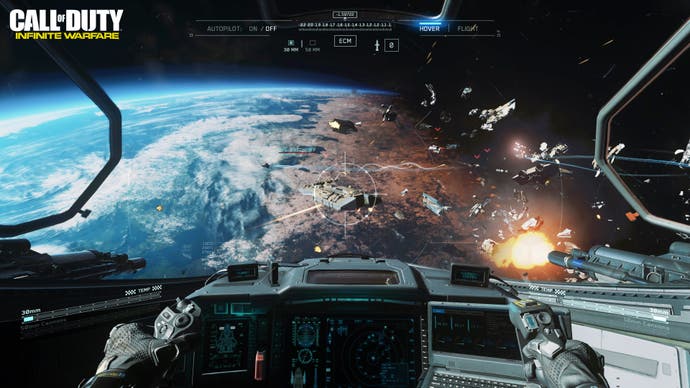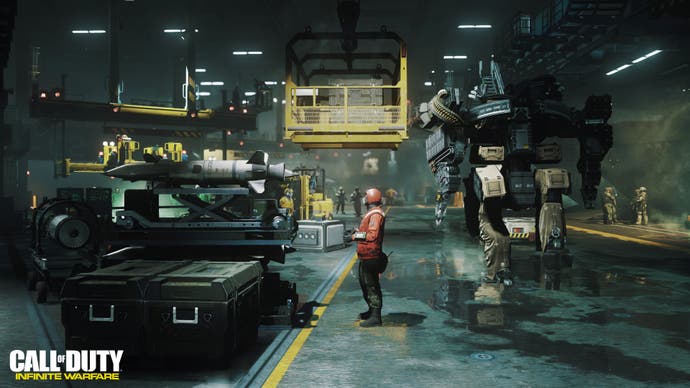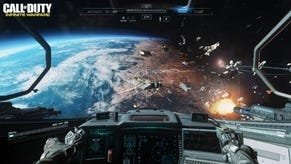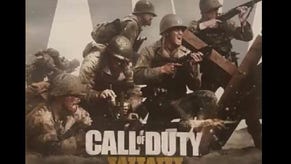How the Call of Duty: Infinite Warfare campaign actually works
Halo Reach meets Mass Effect meets a dash of zero-g.
For all the high-profile negativity surrounding Call of Duty: Infinite Warfare's reveal trailer, the game's campaign actually looks pretty interesting.
In taking Call of Duty into space, developer Infinity Ward has changed the standard Call of Duty campaign in some meaningful ways, not, particularly, in terms of the "boots on the ground" combat, but pretty much everywhere else.
At E3, I had a chat with Infinity Ward design director Jacob Minkoff and narrative director Taylor Kurosaki, and watched a gameplay demo of the game's opening mission, in which the Settlement Defense Front launches a sneak attack on the United Nations-like group that governs space trade and travel. The gameplay demo did a pretty good job of showing how Infinite Warfare's campaign actually works. Let's break it down.
As mentioned, Infinite Warfare kicks off with a sneak attack on the UNSA fleet, which is crippled in the battle. You play Lt. Reyes, a pilot with the Special Combat Air Recon (SCARS) group. Controlling Reyes, you fight alongside some soldiers against SetDef forces on the streets of Geneva. This is classic Call of Duty campaign stuff: cover, ballistics weapons, traditional run and gun combat, lots of explosions and shouting, and the occasional use of a fancy gadget, all silky smooth at 60 frames per second.
Eventually you fight your way onto a hill, where it's all kicking off. Your Jackal, a futuristic fighter plane, lands in front of you and you leap into the cockpit. The scripted sequence sees you take off, while remaining in first person, then burst towards the upper atmosphere alongside friendly ships. Eventually you breach the atmosphere and you're in space, where you see a massive Star Wars-style spaceship battle in the distance. It's here that you're given control over your Jackal, and the space dogfighting portion of Infinite Warfare kicks in.
These dogfights take place in huge goldfish bowls in which you fly around and destroy enemy pilots. Eventually you take down enough pilots to open up a path to shoot out the defences of the main enemy ships.
"It's not on rails," Minkoff says. "You have control to fly wherever you want in that arena. You can't fly around the earth, but there are multiple enemy capital ships and you can fly among them. If you see it and it looks like a thing, you can go to it. It's a pretty big space."
During the initial sneak attack, the commanding officer of The Retribution, a massive UNSA ship, is killed. Lt. Reyes, aka you, takes his place. You lead the fightback against the terrorist group while commanding this massive spaceship packed with thousands of soldiers.
Being boss of The Retribution sounds a bit like commanding the Normandy in Mass Effect. This hub ship, as Infinity Ward calls is, lets you walk around the bridge, check out the Ops map, and choose your missions in a somewhat non-linear fashion.
Side missions are called Ship Assaults. Why bother with them? Well, they reward you with enemy intel, weapon upgrades, equipment upgrades or cosmetic items. But you'll always have missions from Admiral Raines - your boss - on the map that move the story forward.
"You have missions from command, and those form the linear narrative basis of the story," Kurosaki explains. "Early on in the story you get some SetDeF intel that gives you the locations of some of the ship movements of their fleet. So as the CO, you can at your discretion choose to assault those targets of opportunity, maybe getting enemy weaponry, plans and schematics to enemy technology, further intel on their fleet movements and so forth."
One of the more impressive things about Infinite Warfare is how you can seamlessly transition between environments. Take the opening level, for example. From a boots on the ground situation we jump in our Jackal then fly into space. In some missions, rather than blow up an enemy destroyer from the safety of your ship, you can try to board it. Here, you'll pop the canopy of your Jackal, jump out, and enter zero-g combat on the hull, using a thruster to aid movement.
You can then blow up the ship from the inside, hot-footing it back to your Jackal and flying off in suitably dramatic fashion. You fly to The Retribution, jump out and mill about on the bridge - no loading screens throughout.

There are different planets (we know of Titan and an asteroid spinning out of control near the sun) you can go to and different ships you can attack. And there are different types of side missions. Some of these sequences will be hot, and some of them will be stealthy, where you'll pop the canopy to your Jackal and hide in an asteroid field waiting for an enemy ship to jump in. In these situations, you move through, sometimes in disguise, the corridors of an enemy ship behind enemy lines, hearing SetDef soldiers chat about the war.
As mentioned, you can land on Titan, and you can also land on an asteroid that's spinning out of control near the sun. You land on this asteroid to find out what knocked it out of orbit, and where the resources earth is waiting on to help rebuild its fleet got to. Not only are you worried about making sure there's cover between you and the guy who is fighting you, but you have the searing heat of the sun right above you to deal with. You can only move between open areas during this quickly spinning night cycle. So, it's 15 seconds of light and then 15 seconds of dark. It reminds me a bit of cult classic sci-fi Vin Diesel movie Pitch Black.
Your Jackal is a persistent vehicle you upgrade over time. One of the ways you do this is by completing certain Ship Assault missions. For example, one sequence sees you steal an enemy prototype fighter, and then have access to its weapons on your Jackal.
The Retribution also acts as a persistent hub, evolving as the story progresses. It was heavily damaged during the initial sneak attack on Geneva, and you did not have time to resupply before you went out on this mission. As you play through the game, The Retribution finds its feet, and so the bridge sorts itself out.

I get the impression Infinity Ward is keen to stress that Infinite Warfare has the kind of weapons Call of Duty fans are familiar with - despite it leaping into space and ever further into the future - in a bid to reassure the franchise's core fanbase that, actually, don't worry, Call of Duty hasn't gone full Halo. So, when you have boots on the ground stuff going on, most of your weapons are ballistics-based. "We didn't want to be all like pew pew lasers," Minkoff says.
But there are fancy sci-fi gadgets at your disposal, too. One of the new weapons is the Seeker Drone, which is, basically, a grenade with four legs. You can throw it out and it will go to whatever enemy is closest to the middle of your screen, then jump on the enemy and attack it as long as it can find a path there. Once it's on the enemy they'll try to get it off them and ultimately explode. Enemies also have these, too, particularly in stealth scenarios. Say you take out an enemy silently - if he had a Seeker Drone following him, it will come after you. And if it gets you, you have to try to shake it off before it blows up.
Then there's the wrist computer, which you can use to hack various enemies. For example, you can hack a robot inside an enemy dropship and then make it self-destruct, which blows up the dropship. This is a systemic mechanic - an opportunity available when you see an enemy dropship. Or, you can hack individual robots, take over their perspective and attack from them.
In some situations you'll have access to support vehicles, which are triggered from your wrist computer (up on the d-pad). In the Geneva mission you have access to other S.C.A.R.S Jackals, so can call in an airstrike whose use is restricted by a cooldown timer. In other missions you have access to heavy armour or ballistic weaponry.
The zero-g combat involves using a boost pack with thrusters and a grapple hook to help you move about, but in some locations in the game, the boost pack gives you a movement system similar to that in Black Ops 3, so expect plenty of leaping about all over the place.
Infinity Ward will no doubt hope Call of Duty: Infinite Warfare's campaign helps address some of the negativity surrounding the game, fuelled in part by Activision's decision to make the much-anticipated Modern Warfare remaster exclusive to the Legacy, Legacy Pro, and Digital Deluxe editions. For many it won't, and that's understandable, because, come on Activision, we should be able to buy the remaster separately.
The entire situation is a bit of a shame really, as there's a lot going on with Infinite Warfare that's different, at least compared to previous games in the series. I sense a little bit of Halo: Reach in there with the transition from boots on the ground to space dogfighting, a little bit of Mass Effect with the warship and Ops map, and a dash of Star Citizen with the zero-g first-person shooting, which is all good. It would be too much to suggest Infinite Warfare rewrites the Call of Duty rulebook, but the campaign has piqued my interest, and it's been a while since a Call of Duty campaign has done that.















.png?width=291&height=164&fit=crop&quality=80&format=jpg&auto=webp)



